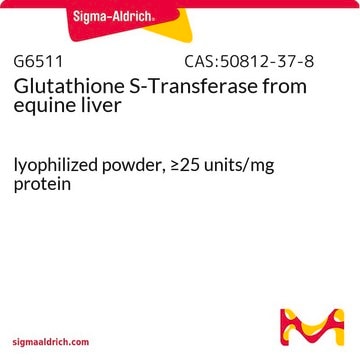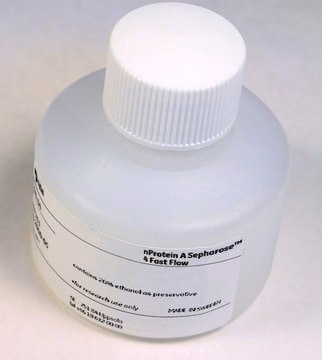GS59
GST M5-5, Recombinant Human
Sinônimo(s):
glutathione S-transferase mu 5
Faça loginpara ver os preços organizacionais e de contrato
About This Item
Código UNSPSC:
12352200
NACRES:
NA.55
Produtos recomendados
fonte biológica
human
Nível de qualidade
recombinante
expressed in E. coli
Ensaio
>95% (SDS-PAGE)
forma
frozen liquid
atividade específica
183.9 units/mg protein
peso molecular
27.4 kDa
concentração
3.2 mg/mL
temperatura de armazenamento
−70°C
Informações sobre genes
human ... GSTM5(2949)
Descrição geral
using spectrophotometric determination of 1-chloro-2,4-dinitrobenzene (CDNB) conjugation with reduced glutathione (1 mM) in 100 mM NaPO4 (pH 6.5) at room temperature.
Ações bioquímicas/fisiológicas
Glutathione S-transferase mu 5 (GSTM5) is an enzyme that in humans is encoded by the GSTM5 gene. Glutathione S-transferases (GSTs) are a family of enzymes that play an important role in detoxification by catalyzing the conjugation of many hydrophobic and electrophilic compounds with reduced glutathione. Based on their biochemical, immunologic, and structural properties, cytosolic and membrane-bound forms of glutathione S-transferase are encoded by two distinct supergene families. At present, eight distinct classes of the soluble cytoplasmic mammalian glutathione S-transferases have been identified: alpha, kappa, mu, omega, pi, sigma, theta and zeta. The GSTs are thought to function in xenobiotic metabolism and play a role in susceptibility to cancer, and other diseases.
The GSTM5 gene encodes a glutathione S-transferase that belongs to the mu class. The mu class of enzymes functions in the detoxification of electrophilic compounds, including carcinogens, therapeutic drugs, environmental toxins and products of oxidative stress, by conjugation with glutathione. The genes encoding the mu class of enzymes are organized in a gene cluster on chromosome 1p13.3 and are known to be highly polymorphic. These genetic variations can change an individual′s susceptibility to carcinogens and toxins as well as affect the toxicity and efficacy of certain drugs. Diversification of these genes has occurred in regions encoding substrate-binding domains, as well as in tissue expression patterns, to accommodate an increasing number of foreign compounds.
Armazenamento e estabilidade
The enzyme should be used by the end-user customer within 1 year of receipt.
Código de classe de armazenamento
10 - Combustible liquids
Classe de risco de água (WGK)
WGK 1
Ponto de fulgor (°F)
Not applicable
Ponto de fulgor (°C)
Not applicable
Certificados de análise (COA)
Busque Certificados de análise (COA) digitando o Número do Lote do produto. Os números de lote e remessa podem ser encontrados no rótulo de um produto após a palavra “Lot” ou “Batch”.
Já possui este produto?
Encontre a documentação dos produtos que você adquiriu recentemente na biblioteca de documentos.
Y V Patskovsky et al.
Biochemistry, 38(49), 16187-16194 (1999-12-10)
The hGSTM3 subunit, which is preferentially expressed in germ-line cells, has the greatest sequence divergence among the human mu class glutathione S-transferases. To determine a structural basis for the catalytic differences between hGSTM3-3 and other mu class enzymes, chimeric proteins
Variation in the GST mu locus and tobacco smoke exposure as determinants of childhood lung function.
Carrie V Breton et al.
American journal of respiratory and critical care medicine, 179(7), 601-607 (2009-01-20)
The glutathione S-transferases (GSTs) are important detoxification enzymes. To investigate effects of variants in GST mu genes on lung function and assess their interactions with tobacco smoke exposure. In this prospective study, 14,836 lung function measurements were collected from 2,108
Ying Wang et al.
Journal of human genetics, 55(8), 490-494 (2010-05-21)
Coronary atherosclerosis is a complex and progressive condition that involves many biological pathways, including the oxidative stress and inflammatory response pathways. To investigate the association between common genetic variation within these two pathways and coronary atherosclerosis, we performed a comprehensive
Christian Delles et al.
Journal of hypertension, 26(7), 1343-1352 (2008-06-14)
Glutathione S-transferases are involved in defences against oxidative stress. We have recently demonstrated reduced expression of glutathione S-transferase mu type 1 (Gstm1) in a rat model of hypertension. Here, we examine the association between GSTM variants and hypertension in human.
Ann M Moyer et al.
Cancer epidemiology, biomarkers & prevention : a publication of the American Association for Cancer Research, cosponsored by the American Society of Preventive Oncology, 19(3), 811-821 (2010-03-05)
Lung cancer is commonly treated with platinum compounds. The "glutathione pathway" participates in the metabolism of platinum compounds. We set out to test the hypotheses that single nucleotide polymorphisms (SNPs) or copy number polymorphisms for genes within the glutathione pathway
Nossa equipe de cientistas tem experiência em todas as áreas de pesquisa, incluindo Life Sciences, ciência de materiais, síntese química, cromatografia, química analítica e muitas outras.
Entre em contato com a assistência técnica







